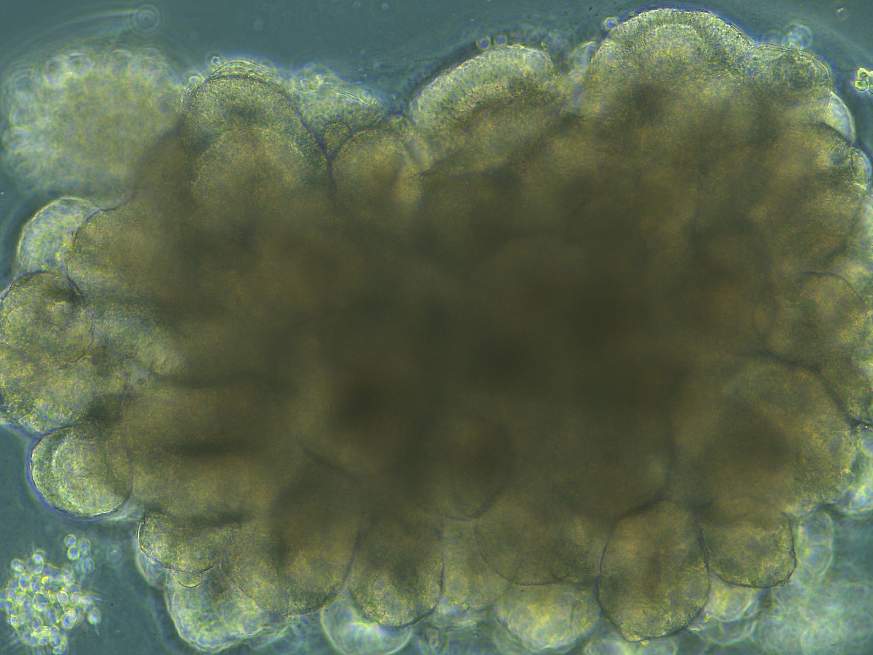You are here
Media Advisory
Friday, June 14, 2019
NIAID scientists develop “mini-brain” model of human prion disease

What
National Institutes of Health scientists have used human skin cells to create what they believe is the first cerebral organoid system, or “mini-brain,” for studying sporadic Creutzfeldt-Jakob disease (CJD). CJD is a fatal neurodegenerative brain disease of humans believed to be caused by infectious prion protein. It affects about 1 in 1 million people. The researchers, from NIH’s National Institute of Allergy and Infectious Diseases (NIAID), hope the human organoid model will enable them to evaluate potential therapeutics for CJD and provide greater detail about human prion disease subtypes than the rodent and nonhuman primate models currently in use.
Human cerebral organoids are small balls of human brain cells ranging in size from a poppy seed to a small pea. Their organization, structure, and electrical signaling are similar to brain tissue. Because these cerebral organoids can survive in a controlled environment for months, nervous system diseases can be studied over time. Cerebral organoids have been used as models to study Zika virus infection, Alzheimer’s disease, and Down syndrome.
In a new study published in Acta Neuropathologica Communications, scientists at NIAID’s Rocky Mountain Laboratories discovered how to infect five-month-old cerebral organoids with prions using samples from two patients who died of two different CJD subtypes, MV1 and MV2. Infection took about one month to confirm, and the scientists monitored the organoids for changes in health indicators, such as metabolism, for more than six months. By the end of the study, the scientists observed that seeding activity, an indication of infectious prion propagation, was present in all organoids exposed to the CJD samples. However, seeding was greater in organoids infected with the MV2 sample than the MV1 sample. They also reported that the MV1-infected organoids showed more damage than the MV2-infected organoids.
The scientists also noted other differences between how the MV1 and MV2 infections evolved in the organoids. They plan to further investigate those differences in hopes of identifying how different subtypes of CJD affect brain cells. Ultimately, they hope to learn how to prevent cell damage and to restore the function of cells damaged by prion infection. The new system also provides opportunities to test potential therapeutics for CJD in a tissue model that mimics the human brain.
Article
B Groveman et al. Sporadic Creutzfeldt-Jakob Disease prion infection of human cerebral organoids. Acta Neuropathologica Communications DOI: 10.1186/s40478-019-0742-2 (2019).
Who
Cathryn Haigh, Ph.D., an investigator in NIAID’s Laboratory of Persistent Viral Diseases, is available to comment on this study.
Contact
To schedule interviews, please contact Ken Pekoc, (301) 402-1663, kpekoc@niaid.nih.gov.
This press release describes a basic research finding. Basic research increases our understanding of human behavior and biology, which is foundational to advancing new and better ways to prevent, diagnose, and treat disease. Science is an unpredictable and incremental process — each research advance builds on past discoveries, often in unexpected ways. Most clinical advances would not be possible without the knowledge of fundamental basic research.
NIAID conducts and supports research — at NIH, throughout the United States, and worldwide — to study the causes of infectious and immune-mediated diseases, and to develop better means of preventing, diagnosing and treating these illnesses. News releases, fact sheets and other NIAID-related materials are available on the NIAID website.
About the National Institutes of Health (NIH): NIH, the nation's medical research agency, includes 27 Institutes and Centers and is a component of the U.S. Department of Health and Human Services. NIH is the primary federal agency conducting and supporting basic, clinical, and translational medical research, and is investigating the causes, treatments, and cures for both common and rare diseases. For more information about NIH and its programs, visit www.nih.gov.
NIH…Turning Discovery Into Health®
